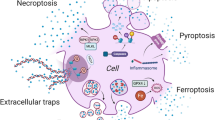Abstract
A comparative study was done using J774A.1 and J774A. 1-derived transfected cells (J774A.1 C.1) containing antisense tumor necrosis factor α (TNF-α) plasmid to determine the role of endogenous TNF-α on nitric oxide production as well as on the growth ofMycobacterium microti in interferon γ (IFN-γ)- and lipopolysaccharide (LPS)-treated cells. On stimulation with IFN-γ and LPS a higher level of NO was observed in J774A.1 cells compared to J774A.1 C.1 which indicated that endogenous TNF-α is required for the production of NO. Comparing the effect of IFN-γ and LPS on the intracellular growth ofM. microti, the growth-reducing activity was higher in J774A.1 cells than in J774A.1 C.1 cells and was not completely abrogated in the presence of the nitric oxide inhibitorN G-methyl-l-arginine (l-NMA). J774A.1 C.1 cells infected withM. microti produced a significant amount of NO when exogenous TNF-α was added along with IFN-γ and LPS and the concentration of intracellular bacteria decreased almost to that in IFN-γ and LPS treated parental J774A.1 cells. Addition of exogenous TNF-α even in the presence ofl-NMA in J774.1 C.1 cells could also partially restore intracellular growth inhibition ofM. microti caused by IFN-γ and LPS. TNF-α is probably required for the production of NO in J774A.1 cells by IFN-γ and LPS but TNF-α and NO are independently involved in the killing of intracellularM. microti with IFN-γ and LPS.
Similar content being viewed by others
References
Antras-Ferry J., Maheo K., Morel F., Guillouzo A., Cillard P., Cillard J.: Dexamethasone differently modulates TNF-α- and IL-1b-induced transcription of the hepatic Mn-superoxide dismutase gene.FEBS Lett. 403, 100–104 (1997).
Appelberg R., Orme I.M.: Effector mechanisms involved in cytokine mediated bacteriostasis ofMycobacterium avium infections in murine macrophages.Immunology 80, 352–359 (1993).
Britton W.J., Roche P.W., Winter N.: Mechanisms of persistence of mycobacteria.Trends Microbiol. 2, 284–288 (1994).
Chan J., Tanaka K., Carroll D., Flynn J., Bloom B.R.: Effects of nitric oxide synthase inhibitors on murine infection withMycobacterium tuberculosis.Infect. Immun. 63, 736–740 (1995).
Chan J., Xing Y., Magliozzo R.S., Bloom B.R.: Killing of virulentMycobacterium tuberculosis by reactive nitrogen intermediates produced by activated murine macrophages.J. Exp. Med. 175, 1111–1122 (1992).
Chomczynski P., Sacchi N.: Single-step method of RNA isolation by acid guanidinium thiocyanate-phenol-chloroform extraction.Anal. Biochem. 162, 156–159 (1987).
Ding A.H., Nathan C.F., Stuehr D.J.: Release of reactive nitrogen intermediates and reactive oxygen intermediates from mouse peritoneal macrophages.J. Immunol. 141, 2407–2412 (1998).
Drapier J.C., Wietzerbin J., Hibbs J.B. Jr.: Interferon-γ and tumor necrosis factor induce thel-arginine-dependent cytotoxic effector mechanism in murine macrophages.Eur. J. Immunol. 18, 1587–1592 (1988).
Fazal N.: The effect ofN G-methyl-l-arginine (NMA), an NO-synthase blocker on the survival of intracellular BCG within human monocyte-derived macrophages.Biochem. Mol. Biol. Internat. 40, 1033–1046 (1996).
Felgner P.L., Gadek T.R., Holm M., Roman R., Chan H.W., Wenz M., Northrop J.P., Ringold G.M., Danielsen M.: Lipofection: a highly efficient, lipid-mediated DNA-transfection procedure.Proc. Nat. Acad. Sci. USA 84, 7413–7417 (1987).
Gupta R., Dogra N., Raje M., Majumder S.: Attempts to characterize the mechanism involved in the growth inhibition ofMycobacterium microti in interferon-γ- or tumor necrosis factor-α-activated J774A.1 cells.FEMS Microbiol. Lett. 140, 171–178 (1996).
Koutný M.: From no-confidence to nitric oxide acknowledgement: a story of bacterial nitric oxide reductase.Folia Microbiol. 45, 197–203 (2000).
Langermans J.A.M., Van Der Hulst M.E.B., Nibbering P.H., Ralph V.F.: Endogenous tumor necrosis factor-α is required for enhanced antimicrobial activity againstToxoplasma gondii andListeria monocytogenes in recombinant γ-interferon-treated mice.Infect. Immun. 60, 5107–5112 (1992a).
Langermans J.A.M., Van Der Hulst M.E.B., Nibbering P.H., Hiemstra P.S., Fransen L., Ralph V.F.: INF-γ inducedl-arginine dependent toxoplasmastatic activity in murine peritoneal macrophages is mediated by endogenous tumor necrosis factor-α.J. Immunol. 148, 568–574 (1992b).
MacMicking J.D., North R.J., LaCourse R., Mudgett J.S., Shah S.K., Nathan C.F.: Identification of nitric oxide synthase as a protective locus against tuberculosis.Proc. Nat. Acad. Sci. USA 94, 5243–5248 (1997).
Marshall B.G., Chanbers M.A., Wangoo A., Shaw R.J., Young D.B.: Production of tumor necrosis factor and nitric oxide by macrophages infected with live and dead mycobacteria and their suppression by an interleukin-10-secreting recombinant.Infect. Immun. 65, 1931–1935 (1997).
Mozaffarian N., Berman J.W., Casadevall A. Enhancement of nitric oxide synthesis by macrophages represents an additional mechanisms of action for amphotericin B.Antimicrob. Agents Chemother. 41, 1825–1829 (1997).
Severn A., Xu D., Doyle J., Leal L.M.C., O'Donnell C.A., Brett S.J., Moss D.W., Liew F.Y.: Pre-exposure of murine macrophages to lipopolysaccharide inhibits the induction of nitric oxide synthase and reduces leishmanicidal activity.Eur. J. Immunol. 23, 1711–1714 (1993).
Sigler K., Chaloupka J., Brozmanová J., Stadler N., Höfer M.: Oxidative stress in microorganisms. I. Microbialvs. higher cells—damage and defenses in relation to cell aging and death.Folia Microbiol. 44, 587–624 (1999).
Zhao B., Collins M.T., Czuprinski C.J.: Effects of γ-interferon and nitric oxide on the interaction ofMycobacterium avium subsp.paratuberculosis with bovine monocytes.Infect. Immun. 65, 1761–1766 (1997).
Author information
Authors and Affiliations
Rights and permissions
About this article
Cite this article
Majumdar, S., Gupta, R. & Dogra, N. Interferon-γ- and lipopolysaccharide-induced tumor necrosis factor-α is required for nitric oxide production: Tumor necrosis factor-α and nitric oxide are independently involved in the killing ofMycobacterium microti in interferon-γ-and lipopolysaccharide-treated J774A.1 cells. Folia Microbiol 45, 457–463 (2000). https://doi.org/10.1007/BF02817621
Received:
Issue Date:
DOI: https://doi.org/10.1007/BF02817621




